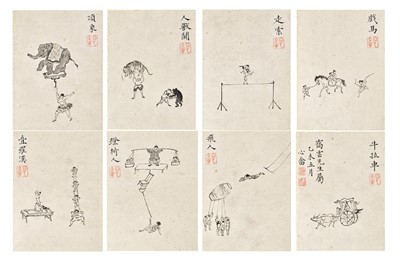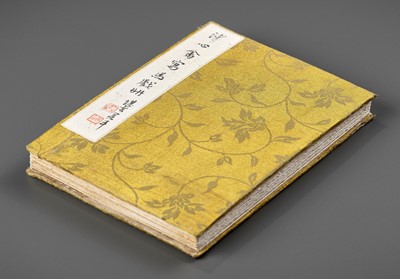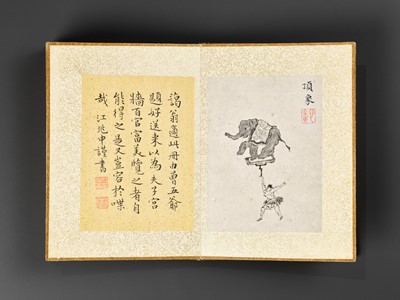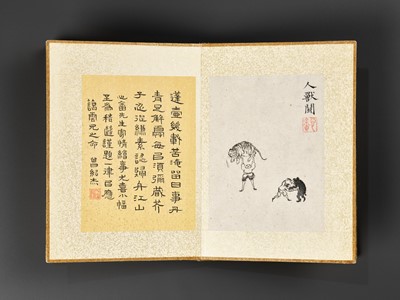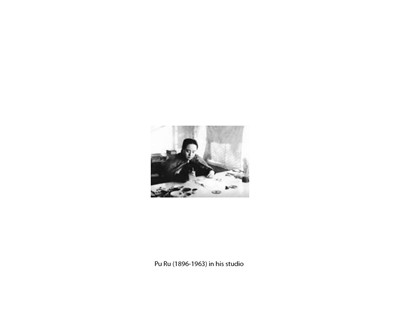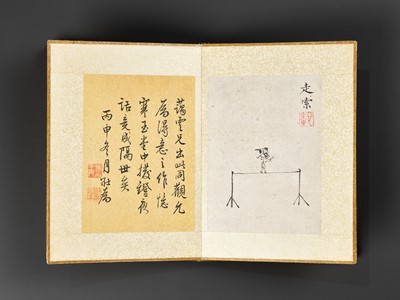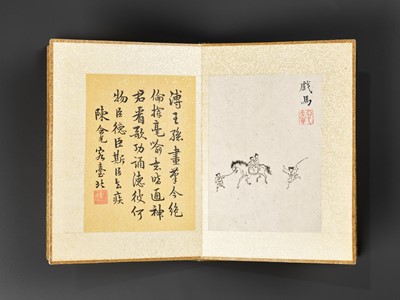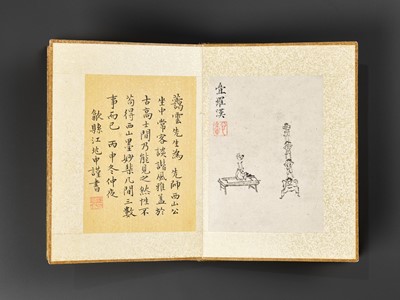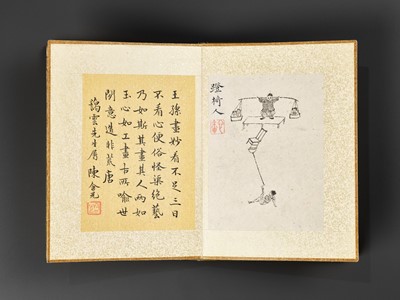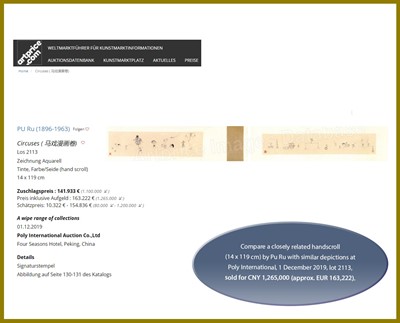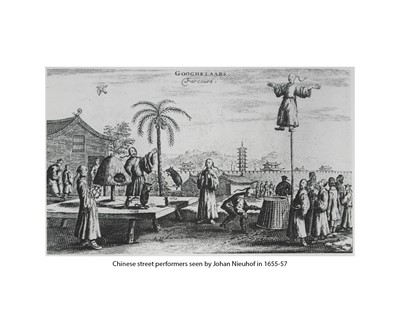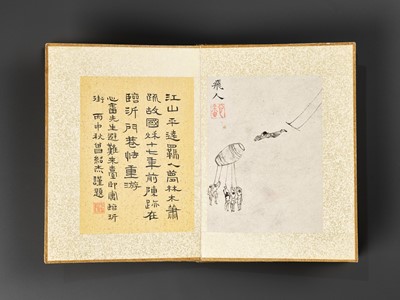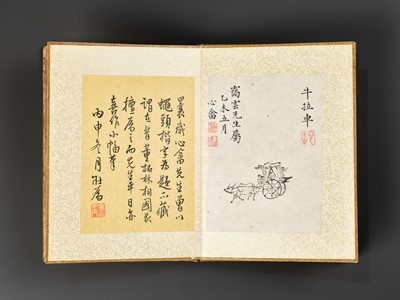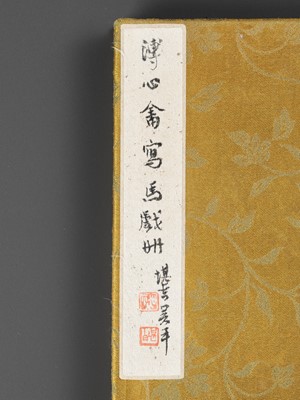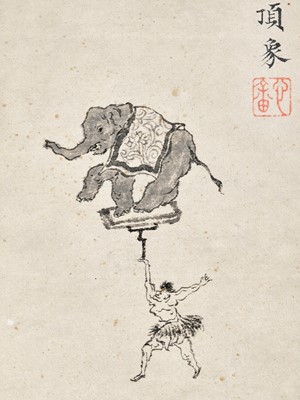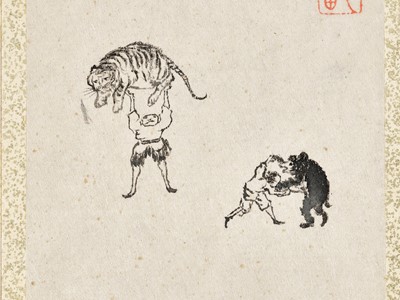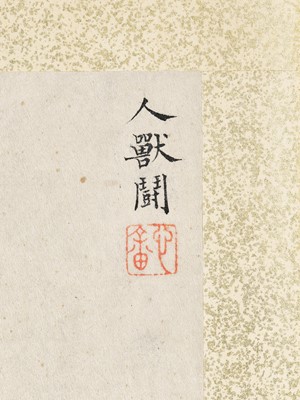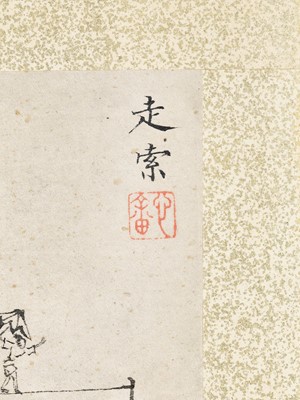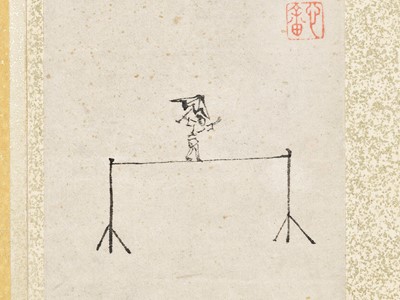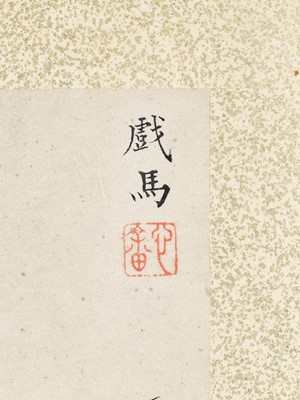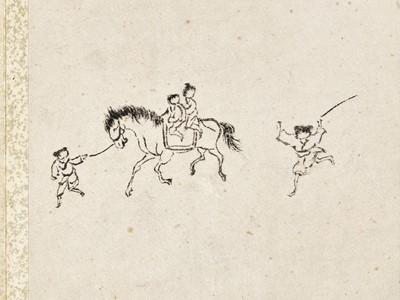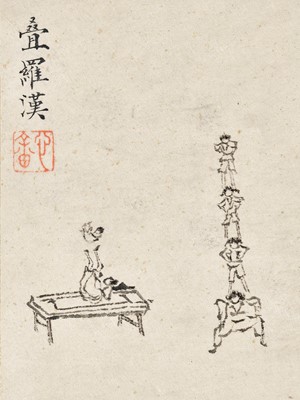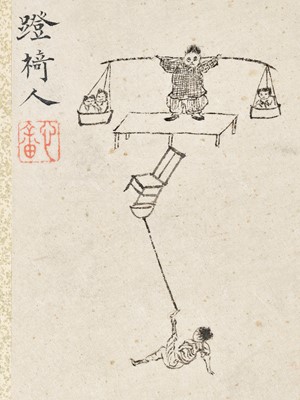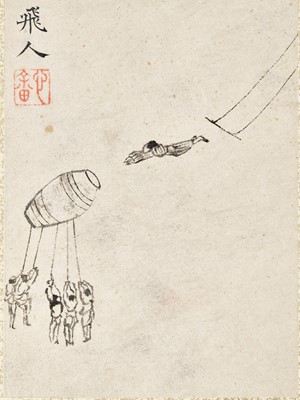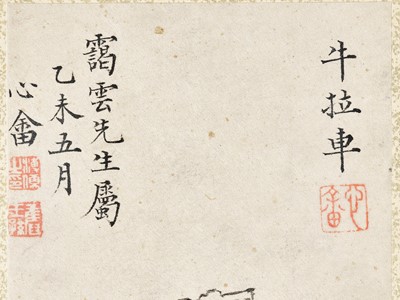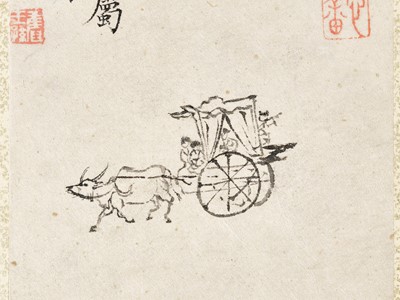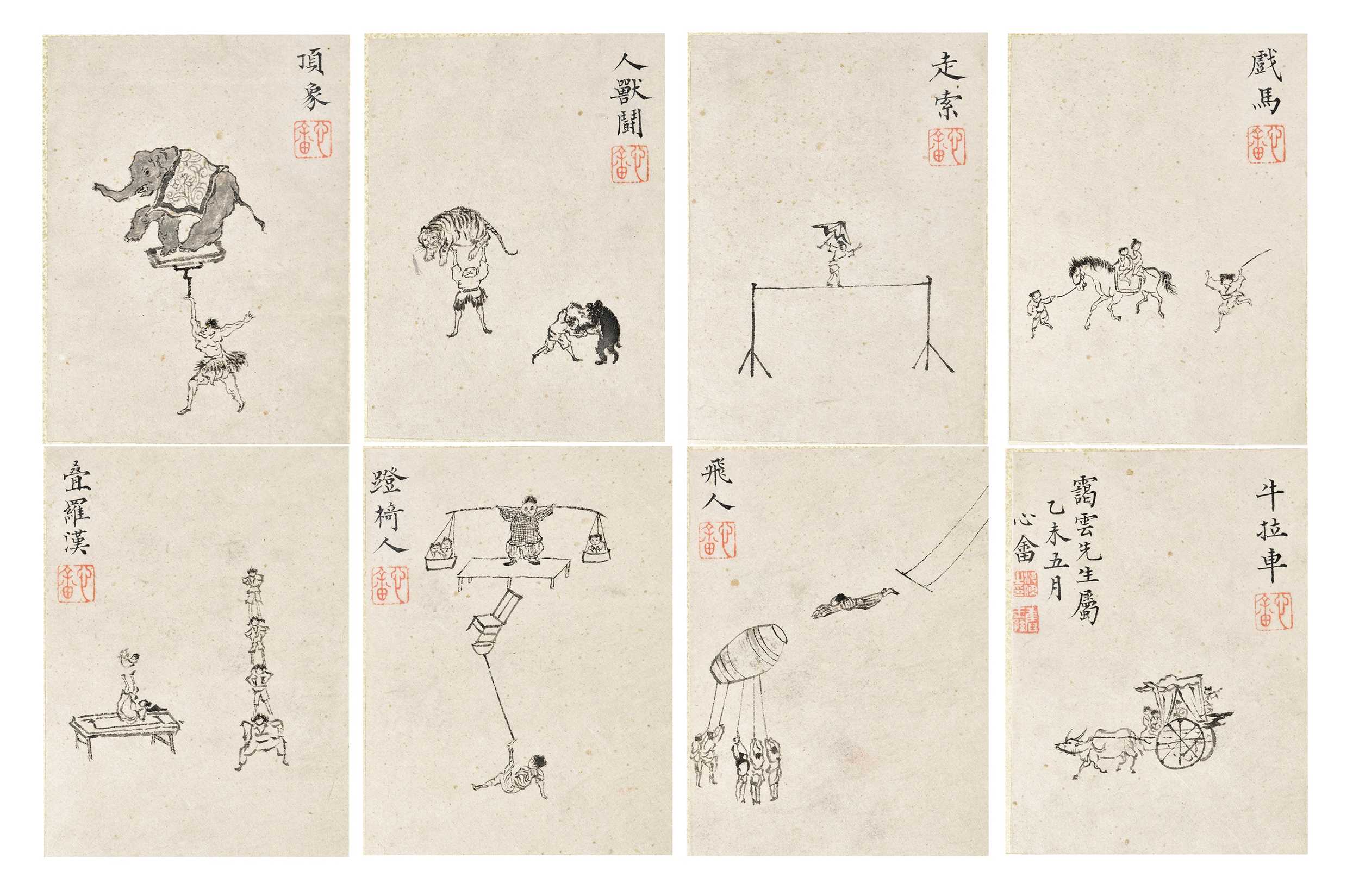11th Mar, 2022 10:00
DAY 2 - TWO-DAY AUCTION - Fine Chinese Art / 中國藝術集珍 / Buddhism & Hinduism
550
‘CIRCUS SCENES’, AN ALBUM BY PU RU (1896-1963), WITH A TOTAL OF 16 LEAVES
《溥心畲寫馬戲冊》,冊頁八開
Sold for €22,752
including Buyer's Premium
China. Ink on paper. The present album consists of eight leaves by the artist, each with a depiction of a different circus act, including acrobats, feats of strength, balancing acts, a tightrope walker, and a trapeze artist, with annotations to each opposite leaf. With silk brocade front and back covers.
Inscriptions: The cover titled ‘Album with Circus Scenes by Pu Xinshe [Pu Ru]’, signed ‘Kanbai Wu Ping’, with two seals, ‘Wu Ping’ and ‘Kanbai’. Each painted leaf with a title. The last leaf signed 'Xinshe', dated Yiwei year (corresponding to 1955), dedicated to Wang Aiyun (1906-2004), and with a total of ten seals of the artist. Each opposite leaf with an annotation, praising Pu Ru and describing his life and art, inscribed and signed by Jiang Zhaoshen, Zeng Shaojie, Wang Zhuangwei, Chen Hanguang, dated Bingshen year (corresponding to 1956), with another dedication to Wang Aiyun, and a total of nine seals.
Provenance: Wu Ping (1920-2019) and thence by descent. Wu, whose style name was Kanbai, was a native of Yuyao in Zhejiang province. He possessed notable talent in the arts of calligraphy, painting, and seal carving, and formerly served as a director of the Department of Painting and Calligraphy at the National Palace Museum, Taipei.
Condition: Very good condition with minor wear, soiling, and foxing. Some old wear and traces of use to album cover.
Dimensions: Image size ca. 11 x 8 cm (each), Leaf size 15.2 x 11.2 cm (each)
Chinese circus acts include a wide range of acrobatic acts, balancing acts and other demonstrations of physical skill traditionally performed by a troupe in China. Many of these acts have a long history in China and are still performed today. While the English term "Chinese circus" has been used to describe Chinese variety arts even in the earliest Western historical texts, the East views the Chinese term ‘circus’ as an altogether separate, Western style of show. Clowns, for example, belong exclusively to the Western circus. Eastern elements include Shaolin monks, Peking opera characters, and the Monkey King.
During the Qin and Han periods, Juedi or Baixi variety shows were popular with the common people. Juedi was originally an entertainment where men wearing horns charged at one another like bulls, but became a general term used interchangeably with Baixi to describe popular entertainment during the Han Dynasty. It consisted of a variety of acts such as conjuring, acrobatics, wrestling, musical performances, dance, martial arts, horsemanship, and juggling. Over the centuries, performances became more elaborate and during the Tang Dynasty, the performing arts were highly popular in the Emperor’s court and the acts became even more refined. Eventually, the performing arts lost favor in the Imperial Court and moved back to the common people and most performers performed in the street. Towards the end of the Ming Dynasty (1368-1644), the performers again came off the street and started performing on stage. During the end of the Qing Dynasty (1644-1911), it regained popularity with the Imperial Court and has remained a popular art form to this day.
Pu Ru (1896-1963), also known as Pu Xinshe, was a traditional Chinese painter, calligrapher, and nobleman. A member of the Manchu Aisin Gioro clan, the ruling house of the Qing dynasty, he was a cousin to Puyi, the last Emperor of China. It was speculated that Pu Ru would have succeeded to the Chinese throne if Puyi and the Qing government were not overthrown after the 1911 Xinhai Revolution. Pu Ru was reputed to be as talented as the famous southern artist Zhang Daqian. Together, they became known as ‘Pu of the North and Zhang of the South’. Pu Ru fled to Taiwan after the Communist Party of China came to power, and was appointed by Chiang Kai-shek as a Manchu representative at the Constitutional National Assembly. In Taiwan, he made a living selling paintings and calligraphy, and taught as a professor of fine arts at the National Taiwan Normal University.
Auction result comparison: Compare a closely related handscroll (14 x 119 cm) by Pu Ru with similar depictions at Poly International, 1 December 2019, lot 2113, sold for CNY 1,265,000 (approx. EUR 163,222).
《溥心畲寫馬戲冊》,冊頁八開
中國。紙本水墨。冊頁中溥心畲繪製了八頁,分別描繪了八個不同的馬戲場景,包括項象、人獸鬪、走索、戲馬、曡羅漢、蹬椅人、飛人、牛拉車。另外八頁則由一些鑒賞家與藏家的相關詩文。綾綿裱褙。
款識:封面:《溥心畲寫馬戲冊》,堪白吳平;鈴印“吳平”“堪白”
最後一頁上書“藹雲先生屬,乙未(1955)五月,心畬。”“藹雲”即為台灣著名收藏家王藹雲(1906-2004)。為冊頁題詞的有江兆申、曾紹傑、陳含光、王壯為,分別落款及鈴印。
來源:吳平 (1920-2019),保存至今。吳平字堪白,生於浙江餘姚,幼承家學,隨父親習字作畫,筆勢結構成自家風格,後來成爲臺北故宮博物院書畫部主任。
品相:狀況極好,有輕微磨損、污漬和起毛。冊頁封面可見使用痕跡。
尺寸:畫面約 11 x 8 厘米,冊頁 15.2 x 11.2 厘米
拍賣結果比較:比較一件溥心畲的卷軸 (14 x 119 厘米),見保利2019年12月1日 lot 2113, 售價CNY 1,265,000 (approx. EUR 163,222)。
China. Ink on paper. The present album consists of eight leaves by the artist, each with a depiction of a different circus act, including acrobats, feats of strength, balancing acts, a tightrope walker, and a trapeze artist, with annotations to each opposite leaf. With silk brocade front and back covers.
Inscriptions: The cover titled ‘Album with Circus Scenes by Pu Xinshe [Pu Ru]’, signed ‘Kanbai Wu Ping’, with two seals, ‘Wu Ping’ and ‘Kanbai’. Each painted leaf with a title. The last leaf signed 'Xinshe', dated Yiwei year (corresponding to 1955), dedicated to Wang Aiyun (1906-2004), and with a total of ten seals of the artist. Each opposite leaf with an annotation, praising Pu Ru and describing his life and art, inscribed and signed by Jiang Zhaoshen, Zeng Shaojie, Wang Zhuangwei, Chen Hanguang, dated Bingshen year (corresponding to 1956), with another dedication to Wang Aiyun, and a total of nine seals.
Provenance: Wu Ping (1920-2019) and thence by descent. Wu, whose style name was Kanbai, was a native of Yuyao in Zhejiang province. He possessed notable talent in the arts of calligraphy, painting, and seal carving, and formerly served as a director of the Department of Painting and Calligraphy at the National Palace Museum, Taipei.
Condition: Very good condition with minor wear, soiling, and foxing. Some old wear and traces of use to album cover.
Dimensions: Image size ca. 11 x 8 cm (each), Leaf size 15.2 x 11.2 cm (each)
Chinese circus acts include a wide range of acrobatic acts, balancing acts and other demonstrations of physical skill traditionally performed by a troupe in China. Many of these acts have a long history in China and are still performed today. While the English term "Chinese circus" has been used to describe Chinese variety arts even in the earliest Western historical texts, the East views the Chinese term ‘circus’ as an altogether separate, Western style of show. Clowns, for example, belong exclusively to the Western circus. Eastern elements include Shaolin monks, Peking opera characters, and the Monkey King.
During the Qin and Han periods, Juedi or Baixi variety shows were popular with the common people. Juedi was originally an entertainment where men wearing horns charged at one another like bulls, but became a general term used interchangeably with Baixi to describe popular entertainment during the Han Dynasty. It consisted of a variety of acts such as conjuring, acrobatics, wrestling, musical performances, dance, martial arts, horsemanship, and juggling. Over the centuries, performances became more elaborate and during the Tang Dynasty, the performing arts were highly popular in the Emperor’s court and the acts became even more refined. Eventually, the performing arts lost favor in the Imperial Court and moved back to the common people and most performers performed in the street. Towards the end of the Ming Dynasty (1368-1644), the performers again came off the street and started performing on stage. During the end of the Qing Dynasty (1644-1911), it regained popularity with the Imperial Court and has remained a popular art form to this day.
Pu Ru (1896-1963), also known as Pu Xinshe, was a traditional Chinese painter, calligrapher, and nobleman. A member of the Manchu Aisin Gioro clan, the ruling house of the Qing dynasty, he was a cousin to Puyi, the last Emperor of China. It was speculated that Pu Ru would have succeeded to the Chinese throne if Puyi and the Qing government were not overthrown after the 1911 Xinhai Revolution. Pu Ru was reputed to be as talented as the famous southern artist Zhang Daqian. Together, they became known as ‘Pu of the North and Zhang of the South’. Pu Ru fled to Taiwan after the Communist Party of China came to power, and was appointed by Chiang Kai-shek as a Manchu representative at the Constitutional National Assembly. In Taiwan, he made a living selling paintings and calligraphy, and taught as a professor of fine arts at the National Taiwan Normal University.
Auction result comparison: Compare a closely related handscroll (14 x 119 cm) by Pu Ru with similar depictions at Poly International, 1 December 2019, lot 2113, sold for CNY 1,265,000 (approx. EUR 163,222).
《溥心畲寫馬戲冊》,冊頁八開
中國。紙本水墨。冊頁中溥心畲繪製了八頁,分別描繪了八個不同的馬戲場景,包括項象、人獸鬪、走索、戲馬、曡羅漢、蹬椅人、飛人、牛拉車。另外八頁則由一些鑒賞家與藏家的相關詩文。綾綿裱褙。
款識:封面:《溥心畲寫馬戲冊》,堪白吳平;鈴印“吳平”“堪白”
最後一頁上書“藹雲先生屬,乙未(1955)五月,心畬。”“藹雲”即為台灣著名收藏家王藹雲(1906-2004)。為冊頁題詞的有江兆申、曾紹傑、陳含光、王壯為,分別落款及鈴印。
來源:吳平 (1920-2019),保存至今。吳平字堪白,生於浙江餘姚,幼承家學,隨父親習字作畫,筆勢結構成自家風格,後來成爲臺北故宮博物院書畫部主任。
品相:狀況極好,有輕微磨損、污漬和起毛。冊頁封面可見使用痕跡。
尺寸:畫面約 11 x 8 厘米,冊頁 15.2 x 11.2 厘米
拍賣結果比較:比較一件溥心畲的卷軸 (14 x 119 厘米),見保利2019年12月1日 lot 2113, 售價CNY 1,265,000 (approx. EUR 163,222)。
Zacke Live Online Bidding
Our online bidding platform makes it easier than ever to bid in our auctions! When you bid through our website, you can take advantage of our premium buyer's terms without incurring any additional online bidding surcharges.
To bid live online, you'll need to create an online account. Once your account is created and your identity is verified, you can register to bid in an auction up to 12 hours before the auction begins.
Intended Spend and Bid Limits
When you register to bid in an online auction, you will need to share your intended maximum spending budget for the auction. We will then review your intended spend and set a bid limit for you. Once you have pre-registered for a live online auction, you can see your intended spend and bid limit by going to 'Account Settings' and clicking on 'Live Bidding Registrations'.
Your bid limit will be the maximum amount you can bid during the auction. Your bid limit is for the hammer price and is not affected by the buyer’s premium and VAT. For example, if you have a bid limit of €1,000 and place two winning bids for €300 and €200, then you will only be able to bid €500 for the rest of the auction. If you try to place a bid that is higher than €500, you will not be able to do so.
Online Absentee and Telephone Bids
You can now leave absentee and telephone bids on our website!
Absentee Bidding
Once you've created an account and your identity is verified, you can leave your absentee bid directly on the lot page. We will contact you when your bids have been confirmed.
Telephone Bidding
Once you've created an account and your identity is verified, you can leave telephone bids online. We will contact you when your bids have been confirmed.
Classic Absentee and Telephone Bidding Form
You can still submit absentee and telephone bids by email or fax if you prefer. Simply fill out the Absentee Bidding/Telephone bidding form and return it to us by email at office@zacke.at or by fax at +43 (1) 532 04 52 20. You can download the PDF from our Upcoming Auctions page.
How-To Guides
How to Create Your Personal Zacke Account
How to Register to Bid on Zacke Live
How to Leave Absentee Bids Online
How to Leave Telephone Bids Online
中文版本的操作指南
创建新账号
注册Zacke Live在线直播竞拍(免平台费)
缺席投标和电话投标
Third-Party Bidding
We partner with best-in-class third-party partners to make it easy for you to bid online in the channel of your choice. Please note that if you bid with one of our third-party online partners, then there will be a live bidding surcharge on top of your final purchase price. You can find all of our fees here. Here's a full list of our third-party partners:
- 51 Bid Live
- EpaiLive
- ArtFoxLive
- Invaluable
- LiveAuctioneers
- the-saleroom
- lot-tissimo
- Drouot
Please note that we place different auctions on different platforms. For example, in general, we only place Chinese art auctions on 51 Bid Live.
Bidding in Person
You must register to bid in person and will be assigned a paddle at the auction. Please contact us at office@zacke.at or +43 (1) 532 04 52 for the latest local health and safety guidelines.
